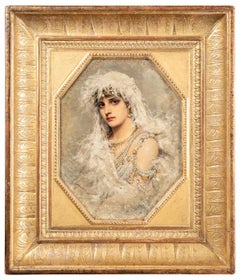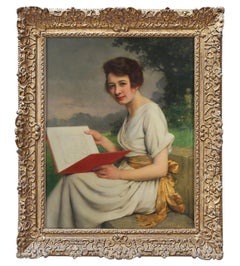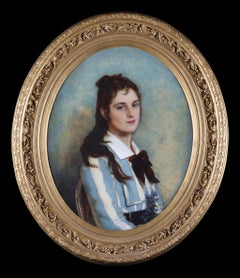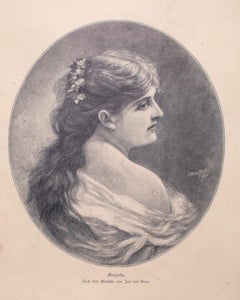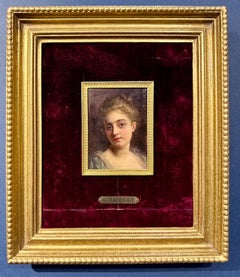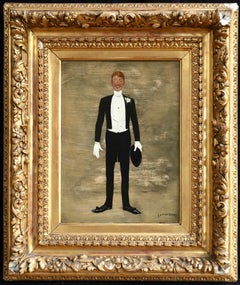Jan Van Beers Art
Belgian, 1852-1927
Jan van Beers is a Belgian artist and son of the poet, Jan van Beers. He studied at Aversa and then moved to Paris, where he worked for Alfred Stevens. He made a lot of illustrations for a lot of magazines, such as Revue illustrée.
to
2
1
1
Overall Width
to
Overall Height
to
2
2
2
1
1
4
3
3
2
2
2
1
1
3
3
1
1
1
4
9,475
2,687
1,375
1,358
2
1
4
Artist: Jan Van Beers
Fleur de Neige, Portrait de Mme Godillot
By Jan Van Beers
Located in Saint-Ouen-sur-Seine, FR
Fleur de Neige by Jan Van Beers, painted in July 1880, stands out for the delicacy of its depiction. This remarkable portrait depicts a woman dressed in a sumptuous white costume, ad...
Category
1880s Old Masters Jan Van Beers Art
Materials
Oil
Portrait of a woman in a garden oil painting on panel by Jan Van Beers
By Jan Van Beers
Located in Gavere, BE
Info artist :
Van Beers studied at the Academy in Antwerp. In 1873, he undertook a trip to London with Alexandre Struys. In 1878, Van Beers went to Paris where he worked in the stud...
Category
Early 1900s Victorian Jan Van Beers Art
Materials
Oil, Wood Panel
The Beautiful Maiden
By Jan Van Beers
Located in St. Albans, GB
Jean Marie Constantin Joseph (Jan) VAN BEERS
Oil on Panel
Panel Size: 32 x 24" (81 x 62cm)
Outside frame Size: 38 x 33" (97 x 83cm)
Van Beers (1852 ...
Category
1870s French School Jan Van Beers Art
Materials
Oil
Woman's Portrait - Original Zincography by Jan Van Beers - 1905
By Jan Van Beers
Located in Roma, IT
Woman's Portrait is an original zincography on paper realized by Jan Van Beers, in 1905.
This Specially Zincography representing a woman's Portrait. The title of the work "Graziella...
Category
Early 1900s Modern Jan Van Beers Art
Materials
Paper
Related Items
Cypriano (A Basque Boy)
By Gerald Leslie Brockhurst
Located in Middletown, NY
Etching on cream wove paper. 6 5/16 x 3 3/4 inches (159 x 94 mm), full margin. Signed in pencil lower center margin, from the edition of 111. A well inked impression with a minor cre...
Category
Mid-20th Century American Modern Jan Van Beers Art
Materials
Handmade Paper, Etching
Portrait of a French 19th century lady in a gilt and ormolu hand made frame
By Gustave Jean Jacquet
Located in Woodbury, CT
Gustave Jaquet
Jacquet was born on 25th May 1846 in Paris. He was a pupil of Bouguereau and for his debut at the Paris Salon in 1865, he exhibited 'The Reverie' which was very much i...
Category
1860s Victorian Jan Van Beers Art
Materials
Oil, Wood Panel
$5,160 Sale Price
20% Off
H 14 in W 12 in
18th Century Venetian School Portrait of a Bishop Oil on Panel Green Brown Black
Located in Sanremo, IT
Painting oil on panel measuring 40 x 30 cm without frame and 48 x 38 with frame representing a great bishop of the Venetian school from the first half of the 18th century.
Very curi...
Category
Early 18th Century Italian School Jan Van Beers Art
Materials
Oil, Wood Panel
$1,132 Sale Price
20% Off
H 15.75 in W 11.82 in D 1.19 in
Portrait of a Mary Hardy (nee Sulman), Late 19th Century Victorian Oil
Located in London, GB
Slade School
Late 19th Century
Portrait of a Mary Hardy (nee Sulman)
Oil on panel
Image size: 8 x 7 inches
Contemporary frame
Provenance
Lady Town (Grandda...
Category
Late 19th Century Victorian Jan Van Beers Art
Materials
Panel, Oil
Male and female portrait, both in silk kimono, possibly textile dealers
By Christoffel Lubieniecki
Located in Amsterdam, NL
CHRISTOFFEL LUBIENIECKI (1659-1729)
Pair of portraits of a gentleman and a lady, both in silk kimono, before a country house (circa 1680)
Indistinctly signed “C.......” on a box under the man’s left hand
Oil on canvas, 79.5 x 67 cm each
Both sitters are portrayed wearing a silk “Japanese” coat. During the second half of the seventeenth the Japanese silk coat, an adapted Japanese kimono, became a real vogue in the Dutch elite. The exclusive Dutch trade contacts with Japan can explain the popularity of the kimono-style silk coats in the Netherlands. Everybody who could afford one, dressed in such a fashionable and comfortable coat and, like the present sitters, some proud owners had themselves portrayed in a “Japanese” coat often together with an oriental carpet to underline their standing and international connections. These portraits are the work of the Polish-born portraitist Christoffel Lubieniecki (also known as Lubienitski, Lubinitski or Lubiniecki)
Lubieniecki was first trained in Hamburg under Julian Stuhr and after 1675 in Amsterdam under Adriaen Backer and Gerard de Lairesse. He specialized in landscapes, generally of an Italianate character, and in portraits. The loving execution of these contented burghers, enjoying the garden vistas of their country house, places him alongside Amsterdam portraitists such as Constantijn Netscher and Michiel van Musscher...
Category
1680s Old Masters Jan Van Beers Art
Materials
Canvas, Oil
$37,762
H 31.34 in W 26.38 in D 1.97 in
Portrait of a Gentleman, Doublet & White Ruff, Gloves Inscribed 1624, on panel
By Frans Pourbus the Younger
Located in London, GB
Titan Fine Art presents this exquisite oil on panel portrait depicting a handsome young gentleman in an exuberant black damask doublet. The pose, with one hand holding gloves and the other akimbo, was one that was well-established for gentleman of the upper echelons of society by the time this work was painted. The principle governing portraits at this time was the recording and defining in visual terms of the position of a sitter in society. In addition to brilliant and complex symbols of luxury, they often contained many symbolic elements too; the inclusion of gloves was often used in portraits that celebrated a betrothal as in ancient times gloves were used to seal a marriage contract.
The extraordinary costume of a black shimmering doublet, the brilliant white reticella ruff, and the cuffs edged with lace were immensely costly… this attire proclaims to every onlooker that this is a superior being. The rendering of the reticella lace ruff is exquisite and the artist has recorded the design that runs through the black damask fabric with meticulous attention to detail. The preservation of this black pigment is remarkable considering the age of the work. Black pigments are especially vulnerable to fade and wear over time partly due to environmental condition but also from unprofessional cleaning. This work is an exquisite example from the period.
According to the inscription in the upper right, the gentleman was in his 22nd year of age in 1624. The coat of arms, which is displayed without a crest, may be ‘blazoned’ in the language of heraldry, as: Sable on a Chevron between in chief two Roundels and in base a Billet [or possibly Square] Or three Martlets Sable. In plainer English this means a black (Sable) background, spanned by a gold (Or) chevron, above which are two golden solid circles (Roundels), and below which is a gold rectangle (Billet); on the chevron are three small black birds (Martlets). Martlets are a stylised form of heraldic bird, believed to be based on the swift, which are conventionally drawn with small tufts instead of feet. In Continental Europe it is also conventional for them to be drawn without beaks, as appears to be the case here. The birds in this instance also have a vaguely duck-like appearance.
Five families have been identified with very close armorial bearings to the one in our portrait. They are the (van) Houthem’s (of Brabant), the Prévinaire’s (of Flanders and Holland), and the Proveneer’s (of Liège) and it must be noted that the locations of these families also fit with the painting’s Flemish origins. However the French Grenières’s (of Île-de-France) and the Jallot’s (of Normandy) are the next closest matches and plausible matches, as Frans Pourbus had settled in Paris just a few years before our portrait was painted.
This painting has been assessed by a professional conservator prior to going on sale, and as thus, it can be hung and enjoyed immediately.
Frans Pourbus the Younger...
Category
17th Century Old Masters Jan Van Beers Art
Materials
Oil, Wood Panel
$17,918
H 42.13 in W 31.11 in D 3.94 in
Alexander the Great in the Darius house
Located in BELEYMAS, FR
French School, Late 18th Century
Alexander the Great in the House of Darius
Oil on canvas
H. 42 cm; W. 53.5 cm without frame
Apocryphal signature lower right "Verhag..."
This painti...
Category
1780s French School Jan Van Beers Art
Materials
Canvas, Oil
19th Century By Giuseppe Molteni Portrait of a Woman Oil on Canvas
Located in Milano, Lombardia
Giuseppe Molteni (Affori (Milano), Italy, 1800 - Milano, Italy, 1867)
Title: Portrait of a Woman
Medium: Oil on canvas
Dimensions: without frame 67 × 55 cm - with frame 91.5 x 80 cm
...
Category
19th Century Old Masters Jan Van Beers Art
Materials
Oil, Canvas
$26,150 Sale Price
20% Off
H 26.38 in W 21.66 in D 1.97 in
German oil painting, Figures in an interior/barn playing, 19th century, Antique
Located in Woodbury, CT
Well painted late 19th-century German genre painting. Often painted in the Munich area of Germany these highly desirable antique paintings are always of t...
Category
1890s Victorian Jan Van Beers Art
Materials
Oil, Wood Panel
$1,720 Sale Price
20% Off
H 14 in W 12 in
Portrait of baron de Roisin - Gendarmerie general
Located in BELEYMAS, FR
Flemish school of the 19th century
Armorial portrait of Baron Henri de ROISIN (1787-1846)
in the uniform of a general of the gendarmerie (1835)
Oil on canvas
H. 108 cm; W. 90 cm
Bar...
Category
1830s French School Jan Van Beers Art
Materials
Canvas, Oil
Impressionist School, second half of the 19th century
Located in Paris, Île-de-France
Impressionist School, second half of the 19th century
Portrait of Two Young Girls
Oil on panel,
28 x 22 cm
Provenance:
Private collection, Paris
This delicate portrait, executed ...
Category
Late 19th Century Impressionist Jan Van Beers Art
Materials
Oil, Wood Panel
$9,600 Sale Price
20% Off
H 11.03 in W 8.67 in
A Portrait of a 55 year old Gentleman
Located in Stamford, GB
A finely painted portrait of Man aged 55 years. Signed, Inscribed and Dated with old Dutch family provenance. He weighs a large white millstone ruff and a black silk tunic.
Category
Mid-17th Century Jan Van Beers Art
Materials
Oil, Panel, Wood Panel
$46,977
H 23.39 in W 19.69 in
Previously Available Items
Celebration - 19th Century Oil, Portrait of Elegant Gentleman by Jan Van Beers
By Jan Van Beers
Located in Marlow, Buckinghamshire
Oil on panel by Belgian painter Jan Van Beers depicting a smiling, elegant gentleman wearing a tuxedo with tails, wearing a monocle and holding a hat...
Category
Early 1900s Impressionist Jan Van Beers Art
Materials
Oil, Panel
The Serenade
By Jan Van Beers
Located in Marlow, Buckinghamshire
A lovely turn of the century depiction of a young man holding a rose in front of a sleeping girl. Beautifully painted oil on panel. Signed lower right. c.1900.
Beers began his artis...
Category
Early 1900s Impressionist Jan Van Beers Art
Materials
Oil, Panel
Jan Van Beers art for sale on 1stDibs.
Find a wide variety of authentic Jan Van Beers art available for sale on 1stDibs. You can also browse by medium to find art by Jan Van Beers in oil paint, paint, paper and more. Much of the original work by this artist or collective was created during the early 1900s and is mostly associated with the modern style. Not every interior allows for large Jan Van Beers art, so small editions measuring 12 inches across are available. Customers who are interested in this artist might also find the work of Edgar Chahine, Charles-Emile Jacque, and James Ensor. Jan Van Beers art prices can differ depending upon medium, time period and other attributes. On 1stDibs, the price for these items starts at $167 and tops out at $11,769, while the average work can sell for $5,968.
Artists Similar to Jan Van Beers
Questions About Jan Van Beers Art
- 1stDibs ExpertFebruary 7, 2024Jan van Eyck was important to the Renaissance because he set new standards for the techniques employed by Northern European artists due to his incredible skill. While Italian Renaissance artists focused on capturing perspective and emotional expressiveness, the Flemish painter was more interested in showing things in exacting detail, so they looked as real as possible. His achievements in this detail and in conveying the differences between light and shadow would influence many other painters. On 1stDibs, find a wide range of fine art.
